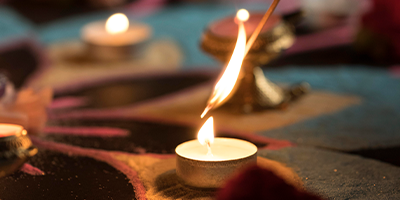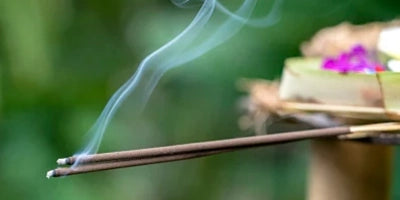
Incense in Hindu Rituals: Symbolism and Significance
Walk into any Hindu temple or home during prayer, and you'll smell the calming aroma of lit incense. The smoke twisting upward and carrying a mix of fragrant herbs and resins, creates an atmosphere of tranquility and respect.
But incense sticks (agarbattis) mean more than just sweet-smelling add-ons—they have a deep spiritual importance representing devotion, cleansing, and the link between earth and heaven. Incense has been crucial in Hinduism, from old Vedic customs to today's worship.
Let's dig into the deeper meaning of incense sticks, their importance in rituals, and how they help in spiritual practices.
The Ancient Origins of Lighting Incense
The custom of lighting incense goes back to the Vedic era when people offered sweet-smelling substances like sandalwood, frankincense, and myrrh in fire sacrifices (yajnas) to please the gods. The Rig Veda says that people thought the holy smoke cleaned the area and took prayers up to the sky. As time passed, incense became a key part of everyday rituals, offerings at temples, and spiritual activities. (SOURCE)
Symbolism of Incense in Hinduism
Lighting incense holds deep symbolic meaning in Hinduism representing various spiritual ideas:
-
Link Between People and the Divine: The smoke that rises is thought to carry prayers and wishes to the gods serving as a connection between the physical and spiritual worlds.
-
To Clean Space and Mind: The scent helps to clear the area of bad energies making a holy place to worship and meditate.
-
Gift of Faith: The slow burn of incense stands for giving in to the divine, with the smoke showing the melting away of self and attachment.
-
Standing for the Five Elements: In Hindu beliefs about the universe, incense smoke embodies the air element (Vayu) adding to fire (Agni) from the flame, earth (Prithvi) from the wooden stick water (Jala) in the base paste, and space (Akasha) as the smoke spreads out.
Ritual Significance of Incense Sticks
Hindu rituals primarily revolve around invoking divine energies, and incense sticks play an important role in religious practices:
1. Daily Puja
In temples and households, lighting incense is a daily ritual to invite divine blessings. The sweet aroma creates a tranquil environment for prayer and meditation.
2. Special Ceremonies and Festivals
From weddings to Diwali and Navratri, agarbattis are an essential element in all sacred Hindu ceremonies, believed to purify the space and usher in auspiciousness.
3. Shraddha Ritual
During the ancestral ritual period of shraddha, agarbattis are lit ceremoniously to offer respect and facilitate the peaceful transition of the departed souls of our ancestors (Purvajas). The fragrance of agarbattis is believed to guide the soul towards liberation (Moksha).
4. Meditation and Spiritual Practices
Yogic practice and spiritual journey rely on agarbattis to aid concentration, elevate consciousness, and create an ambiance of mindfulness.
Benefits of Agarbattis Beyond Rituals
Beyond the role played in important rituals, agarbattis offer other benefits for our spiritual and mental well-being:
-
Improving Focus and Concentration: It is believed that some aromas help calm our minds down, making them a great add-on during meditation and deep contemplation sessions.
-
Cleansing Aura: Herbs and resins, like camphor and frankincense, infused in agarbattis, are believed to ward off evil and cleanse the aura.
-
Creating a Purified Surrounding: The soothing scent transforms any space into a sanctuary of peace and devotion.
-
Aligning the Chakras: Regularly using incense in prayers helps maintain discipline in spiritual practices, reinforcing the connection to divine consciousness and realization within.
-
Balancing Peace of Mind: The calming effect of incense can lower stress levels, making it a natural aid for relaxation and inner balance.
The Influence of Incense in Hindu Art and Literature
Incense holds a revered place in Hindu scriptures, art, and literature:
-
The Bhagavad Gita mentions offerings of incense as an act of devotion to the divine.
-
Ancient temple sculptures depict sages and priests holding incense burners as part of sacred rites.
-
Classical Indian poetry often describes the fragrance of incense as a metaphor for divine love and enlightenment.
Global Adaptation of Hindu Agarbatti Practices
The traditions of lighting an agarbatti have influenced cultures worldwide. Many Buddhist and Taoist practices have adopted agarbattis from Indian rituals. Ayurvedic and holistic wellness communities worldwide also use agarbattis for meditation, yoga, and healing practices.
Final Thoughts: A Fragrant Path to the Divine
The presence of agarbattis in Hinduism goes far beyond just their pleasant fragrances. They act as powerful tools for practicing devotion, purification, and establishing a spiritual connection. Used in a temple, home, or personal meditation space, the smoke and aroma from agarbattis remind us of the fragility of life, the existence & presence of the divine, and the importance of mindful worship.
So the next time you light an agarbatti, take a moment to embrace its deeper significance—let the fragrance guide you to a place of inner peace and spiritual awakening. The ritual significance and benefits of incense sticks make them an invaluable element of Hindu tradition, symbolizing the eternal connection between humankind and the divine.















